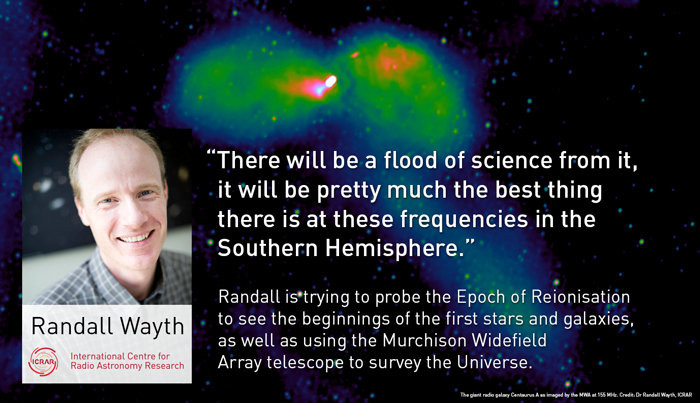“It will be pretty much the best thing there is at these frequencies in the southern hemisphere,” he said. “There will be a flood of science that follows from that survey. Surveys tend to be quite well cited and well used data products just because people think to use them for something that you yourself wouldn’t have thought of.”
In addition to his efforts with the MWA, Dr Wayth is working on a separate project in the Murchison called BIGHORNS. This experiment will probe the Epoch of Reionisation, a period early in the history of the Universe when the first stars and galaxies were beginning to form.
Dr Wayth completed an undergraduate in electrical engineering and computer science and worked in industry as a software consultant for five years before turning to astronomy. “I realised that I probably didn’t want to work in industry for the rest of my life, that I’d rather do something that was a bit more noble and contribute to the sum total of human knowledge,” he said. He had always been interested in astronomy so undertook a PhD in astrophysics at the University of Melbourne and then a postdoctoral position at the Harvard-Smithsonian Center for Astrophysics before returning to Australia to join ICRAR.
Dr Wayth said he enjoyed the way that radio astronomy still gave him the chance to use everything he learnt in his undergraduate electrical engineering degree. He said with so many projects going on at once, ICRAR is an interesting and dynamic place to be. “The people here are fantastic, it’s a very dynamic workplace,” Dr Wayth said. “We have lots of projects going on so it’s a good place where you can get involved in lots of things.”
The Murchison Widefield Array is a radio telescope in the WA desert about 9 hours drive from Perth, Western Australia. It’s the first operational precursor to the Square Kilometre Array radio telescope (ska.gov.au). An innovative design, the MWA has no moving parts and instead relies on sheer computing power to point in the sky and observe the distant (and close by) Universe. More information on the MWA is available at http://mwatelescope.org.
A timelapse taken at night of a tile of the MWA. Credit: Pete Wheeler, ICRAR.
Dr Randall Wayth is working on two of ICRAR’s most exciting projects, the Murchison Widefield Array (MWA) telescope and an experiment to find out more about the beginnings of the Universe. As a Commissioning Scientist for the MWA, Dr Wayth is leading a program that aims to survey the entire sky at low frequencies with the innovative telescope.
